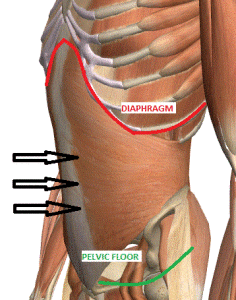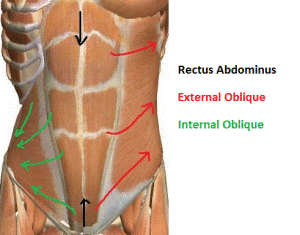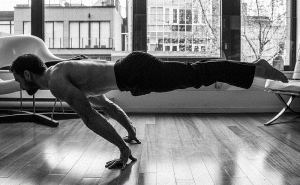What is my core? Abdominal bracing vs. Transverse Abdominis
Contents
The purpose of this article is to help give you a true understanding of your core and core stability. I will explain the two main theories on how humans protect their spines; abdominal bracing and abdominal hollowing.
Our understanding of the human body and human movement is continually evolving. Believe it or not, we still don’t understand everything about how our bodies work.
Results from new studies are regularly released which challenge long held theories and opinions. These theories and opinions are ingrained in to health/fitness professionals knowledge during their training. Often, it can take time for new ideas, techniques and knowledge to trickle through and become the norm.
When you have finished reading this, you may understand true core stability more than some trainers or therapists.
What is my core and what is core stability?
The term core stability has been bandied about and debated within the exercise and rehab community for years. What is my core, and why should I care, I hear you ask?
There have been many different descriptions used to describe the core but this is the one I prefer. Your core is your body minus your arms and legs. The term ‘core stability’, refers to your body’s ability to stabilize your spine using your torso muscles.
In addition to stabilising your spine, a healthy working core is a vital component of all human movement. If your core isn’t activated when you reach overhead, then sooner or later you will develop back pain or injure your shoulder. It may not happen the first time you move incorrectly or the 10’000th time, but one day something will have to give.
As I mentioned before, there are many different descriptions used to describe core stability. There are also different theories about which muscles are important when it comes to stabilizing your spine and preventing back pain.
The two main theories centre around the importance (or lack of importance) of a deep abdominal muscle called the Transverse Abdominis (referred to as the TVA in the rest of this article). If you have spent much time in gyms or attended Pilates classes in the last fourteen years you may well of heard of it.
Warning: The following part of this article is going to get geeky. The human body is very complicated and there is no simple way of explaining this stuff. If this doesn’t sound like your cup of tea and you are not interested in the hows and whys, just practice setting your core by following the link at the bottom of the page.
Remember though, the more you learn about your body, the more control you have over your posture and pain.
Abdominal Hollowing (TVA).
In 1999 a clinical group in Australia (Richardson, Hodges, et all), discovered motor control disturbances (disturbed movement patterns) in the TVA and Multifidus muscles. These occurred, in some people following injury or the onset of back pain.
They theorised that dysfunction and poor motor control in these muscles compromised core stability. Their conclusion was that delayed contraction of the TVA creates faulty motor patterns and compromises the spine.
The exercise and rehabilitation community went nuts for this. Particularly the Pilates and Personal Training crowd. Unfortunately, as usually happens with these things, people misunderstand and over simplify things. What happened, was that everybody concentrated on training the TVA at the expense of everything else.
Trainers and Pilates instructors were stuffing blood pressure cuffs under peoples backs and telling them off when any other muscle started working. Physical therapists were using ultra sound and electrical stimulators to ensure that the TVA was working and firing at the correct time. A whole industry was created selling wobble boards and inflatable gym balls.
The idea behind all this was that the TVA should contract before any other muscle, during any movement. This is supposed to do two things. Firstly increase ‘intra-abdominal pressure’ (pressure in your belly that helps stabilise your spine) and secondly correct the faulty motor control problem identified in the original study.
The abdomen can be thought of as a sealed  chamber with the diaphragm forming the lid and the pelvic floor muscles forming the base. The TVA wraps around the abdomen like a belt and attaches into the thoracolumbar fascia (a diamond shaped piece of connective tissue at the base of the spine).
chamber with the diaphragm forming the lid and the pelvic floor muscles forming the base. The TVA wraps around the abdomen like a belt and attaches into the thoracolumbar fascia (a diamond shaped piece of connective tissue at the base of the spine).
When the TVA contacts it increases the pressure inside the abdomen (intra-abdominal pressure) thus adding stability to the spine.
Does consciously contracting the Transverse Abdominis increase spinal stability? In my opinion yes, but only very slightly and only during certain circumstances. The TVA is however, only one thin sheet of muscle and it’s not strong enough to stabilise the spine on it’s own during most human movement.
Drawing in the lower abdomen (using the TVA) also slightly narrows the base of support of the torso. This narrower base of support actually decreases stability. It’s a bit like squeezing the centre of a new tube of toothpaste. Once you have squeezed it, the tube just becomes more floppy.
Contracting the TVA also seems to turn off other abdominal muscles. This is particularly true with the internal oblique muscles which are very important when it comes to preventing or controlling rotation of the trunk.
I tried isolating the TVA with my clients for several years (in spite of my misgivings). I helped them to strengthen their TVA and also ensured that they activated it prior to every exercise. Guess what, I never saw any improvement in their posture or any reduction in their back pain!
This theory is now over 14 years old. Some of the experts who were part of the original study even state, that the TVA shouldn’t be worked in isolation. Despite this, a lot of trainers and therapists are still obsessed with strengthening this muscle.
There are still trainers, therapists and Pilates instructors out there laying people on their backs and instructing them to pull their belly buttons towards their spine. You know what the main problems is….. we don’t live on our backs!
There are only two circumstances when I concentrate on training this muscle with my clients.
- When I assess a client and they cannot actively contract their TVA at all, I teach them to do it and then leave it alone.
- When a client is expecting or just had a baby I get them to strengthen their TVA as it helps to restore their abdomen and get the pelvic floor muscles to kick in (An active contraction of the TVA causes a co-contraction of the pelvic floor and vice versa).
Abdominal bracing.
I first came across Dr Stuart McGill (University of Waterloo, Canada) when I bought his book “Low back disorders” on a whim back in 2007. It was one of those Eureka moments when I finally found some documented evidence that confirmed what I felt when I moved and what I saw every day with my clients.
McGill challenged the importance of the TVA muscle in relation to spinal stabilisation and back pain. McGill’s theory is that all of the torso muscles are important when it comes to preventing back pain and stabilizing the spine.
TVA muscle in relation to spinal stabilisation and back pain. McGill’s theory is that all of the torso muscles are important when it comes to preventing back pain and stabilizing the spine.
There is no ‘wonder muscle’ that protects the spine or stops back pain from occurring. Rather, any muscle (or group 0f muscles) can be the most important stabilizer of the spine at any one instance of time.
The importance of individual muscles will subtly change dependent on task required. Muscles work together in multiple directions to sustain posture, create movement, prevent movement and maintain stability.
McGill championed a technique known as abdominal bracing. This is a technique that can be used to stiffen your truck and protect your spine. Abdominal bracing creates much more intra abdominal pressure than a solitary TVA contraction.
As bracing activates multiple muscles, many different lines of stiffness are created. Some of these lines of stiffness can be seen in the picture above.
Just like the theory behind abdominal hollowing, it’s the motor control that important. In other words, your body needs to re-learn how to move in a safe organised way. It’s not all about strength!
Learning abdominal bracing
Abdominal bracing, is in my opinion something that should happen subconsciously. The reason it doesn’t occur automatically in everyone, is that we lead such sedentary lifestyles. We all spend so much time sitting in a relaxed state that our bodies just forget how to stabilize properly.
I often find that new clients lack this automatic bracing. These are usually the same people who suffer with back pain.
By practicing abdominal bracing you will start to ingrain stability into your everyday movement. Eventually abdominal bracing should become a subconscious action whenever you lift an object or move.
To learn how to use abdominal bracing please see ‘Prevent injuries using abdominal bracing’.
If you think this article could be useful to someone you know, please help spread the word and share it.

Loved your article. Quick question. I’m a pilates teacher and wonder if bracing would inhibit in exercises where spine mobility is in focus. Is it possible to flex extend and laterally flex without feeling restricted during bracing? Many thanks
Can abdominal bracing be achieved also by taking in a deep ab breath and blowing up a balloon, without sucking the abs in hard?
What I mean by “without sucking abs in hard” is by just letting them naturally come in as they would by exhaling in the balloon??
Thanks!
Bracing shouldn’t envolve ‘sucking the abs in’ at all as this is more of a TVA activation cue. What you are describing though is a great way to teach people to brace and the balloon description is a cue I often use with clients.
‘Take a deep belly breath (diaphramatic) and hold it. Now blow out like you are blowing up a balloon’.
You may also want to read the following http://sortyourpostureout.com/prevent-injuries-using-abdominal-bracing/
Hi.
Thanks for your quick and excellent reply. I appreciate it. :).
So, if I want to use the balloon as a cue for ab bracing, I could use it to practice ab bracing?
Yes, I also just meant blowing out normally into balloon, and letting abs come in as they “normally would” by blowing the balloon up…not forcefully sucking them in as with ab vacuums.
Thanks!
Sincerely, Randy
H Randy,
Yes absolutley its a great cue. Just out of intrest, where did you learn it, or is it something you came up with yourself?
I’m happy I’ve found your post. I developed diastasis recti after giving birth to my son, back 11 months ago. I have that typical pregnant posture and tummy and I have upper back pain. I’m planning to purchase an online postnatal exercise program. I am doing my research which to choose. As I see, most of them use the abdominal hollowing.
Have I understood correctly that you also prefers hollowing to bracing in case of DR? Or should I choose the company (if it also offers online courses) you mentioned, which uses abdominal bracing? Could you send me the name of the company?
Many thanks,
I know this article is a few years old, but I’m curious and hopefully you still answer questions on this. After having a “tummy tuck” recently, I had heard about the technique used by a company for improving diastasis recti, which I think you may possibly be referring to in your June 2013 response. I had been told (by another tummy tuck patient) that after the procedure, we should not be doing crunches, planks, or any similar abdominal exercises, only the abdominal hollowing exercise they advocate. Supposedly, those typical ab exercises will cause problems for those who have had a tt with muscle tightening. I’ve tried to find information about this by professionals, but haven’t had any luck, so I continue to do the exercises my trainer has me do–many variations of the typical plank, crunch exercises, along with weight lifting, cardio, etc.
Quite by accident, I only recently realized that it was possible to use the bracing technique as opposed to the hollowing (I have been using what seems like a combination of the two, or just the hollowing). I asked my trainer about it and he gave me the term “bracing”, which is how I found your article.
I’m curious what your opinion is or if you have one, about using either technique after muscle tightening?
Obviously, I haven’t assessed you so therefore can’t give individual advice. I agree with your friend in relation to avoiding crunches. I never give them to any client and haven’t for over a decade. They are just bad for the spine. I prefer to train peoples abdominal muscles with them standing up anyway. Performing crunches postnatally can also cause permanent damage to the linea alba. With post natal clients, I still use hollowing as there is often a co-contraction of the pelvic floor. That’s the only reason i use it. The moment the diastassis recti closes back up, I return the client to bracing. I must admit though, its been a few years since I had post natal client (I may be out of date). I would therefore research it again if I got a post natal client and act accordingly.
As I mentioned at the beginning, I cant give specific advice without assessing someone. I also don’t know the details of your surgery and exactly which part of the fascia they tightened..Therefore, the following does not constitute advice. In theory, if a client had been given a vertical tummy tuck and the fascia around the linea alba had been tightened I would treat them in the same way as a post natal client. I would probably return them to bracing after around two months and would be limiting them to very light loads anyway. This would be dependant on how well them had healed though. I still wouldn’t use hollowing as I don’t believe it does any good at all outside of pelvic floor control.
In yoga, there is much esoteric talk about the mula-bandha (which no-one seems able to teach, but which I think is the TVA activation) and the jaladara-bandha (which is lowering the chin, raising the chest and generally straightening out of the neck vertebrae.) This is the recommended (seated) posture for pranayama and meditation. (Iyengar)
In tai-chi (actually, nei-kung (a more basic version)) the fundamental posture is 1)head held “as if suspended from a hook in the crown of the skull) – which brings the chin down and chest up, and 2)pelvis nutated forward, ie tucked in, with legs bent and weight on toward the heels. To me, this feels a standing version of the yoga posture. The “suspended from a hook” marionette head advice is also given, i hear, to dancers and models.
The point of both these is to concentrate energy in the center of the thorax – which it does immediately and admirably. Both of these – the TVA activation and the “suspended from a hook” are particularly interesting because, once “activated” they seem to “stick” in that (good) position. Ie, the abdomen stays compactly “in” and the neck feels a lot stronger. . . . .
Any comment on this? – Because, to my knowledge, yoga people, taichi people and body-builders have not been comparing notes, . . . .
Nice post.
Fantastic article, I am an exercise therapist from South Africa and totally agree with what you are saying about the TVA. I will look into this abdominal bracing however from my opinion bracing only happens when you need to brace for something like when taking a tackle or being punched in the stomach. Bracing will stiffen up the body and not allow natural flow of movement in the body especially rotation.
So glad that I am not the only one who thinks that focusing on TVA is not functional and normal. Look forward to more of your articles.
Great article, I’ve just finished reading McGill.
In regards posture, would you recommend a small amount of abdominal hollowing to “lift the chest”.
Would this be an example of where abdominal hollowing would be ok?
Many thanks
Hi Alex, Thanks for the nice comment and thanks for being the first commenter on my new site.
In answer to your question, other than my post natal clients I don’t use hollowing at all anymore. I just check that every client can activate their TVA at will, then leave it alone. In fact, a well known company who specializes in ante/post natal exercise education emailed me last week about this subject. Even they have stopped recommending hollowing.
In regards to ‘lifting the chest’, I would ask why specifically you would want to lift the chest? Don’t get me wrong, the alignment of the thorax in relation to the pelvis is very important when it comes to posture. However, the TVA has in my opinion very little (if anything) to do with thoracic extension (i.e. lifting the chest) or maintaining the correct alignment of the pelvis to the thorax.
Have you been told that you have flat back or sway back posture or is ‘lift the chest’ from Pilates? (‘Lift the chest’ sounds a bit Pilates).
Thanks
Posture Sleuth